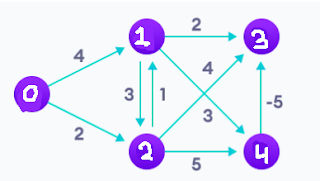Assignment 5: Write a program to print shortest path and cost for the directed graph using Bellman Ford algorithm (Dynamic Programming) and verify the complexity.
Problem Statement: Write a program to print shortest path and cost for the directed graph using Bellman Ford algorithm (Dynamic Programming) and verify the complexity.
THOERY:
Given a graph and a source
vertex src in graph,
find shortest paths from src to
all vertices in the given graph. The graph may contain negative weight edges.We have discussed Dijkstra’s
algorithm for this problem. Dijkstra’s algorithm is a Greedy algorithm
and time complexity is O(VLogV) (with the use of Fibonacci heap). Dijkstra doesn’t work for Graphs with
negative weight edges, Bellman-Ford works for such graphs. Bellman-Ford is also
simpler than Dijkstra and suites well for distributed systems. But time
complexity of Bellman-Ford is O(VE), which is more than Dijkstra.
Algorithm
Following are the detailed steps.
Input: Graph and a source vertex src
Output: Shortest distance to all vertices from src. If there is a
negative weight cycle, then shortest distances are not calculated, negative
weight cycle is reported.
1) This step initializes distances from the source to
all vertices as infinite and distance to the source itself as 0. Create an
array dist[] of size |V| with all values as infinite except dist[src] where src
is source vertex.
2) This step calculates shortest distances. Do
following |V|-1 times where |V| is the number of vertices in given graph.
a) Do following for each edge u If dist[v] > dist[u] + weight of edge uv, then update dist[v] dist[v] = dist[u] + weight of edge uv
3) This step reports if there is a negative weight cycle in
graph. Do following for each edge u-v
……If dist[v] > dist[u] + weight of edge uv, then “Graph contains negative
weight cycle”
The idea of step 3 is, step 2 guarantees the shortest distances if the graph
doesn’t contain a negative weight cycle. If we iterate through all edges one
more time and get a shorter path for any vertex, then there is a negative
weight cycle
How does this work?
Like other Dynamic Programming
Problems, the algorithm calculates shortest paths in a bottom-up manner. It
first calculates the shortest distances which have at-most one edge in the
path. Then, it calculates the shortest paths with at-most 2 edges, and so on.
After the i-th iteration of the outer loop, the shortest paths with at most i
edges are calculated. There can be maximum |V| – 1 edges in any simple path,
that is why the outer loop runs |v| – 1 times. The idea is, assuming that there
is no negative weight cycle, if we have calculated shortest paths with at most
i edges, then an iteration over all edges guarantees to give shortest path with
at-most (i+1) edges (Proof is simple, you can refer this or MIT Video Lecture)


Comments
Post a Comment